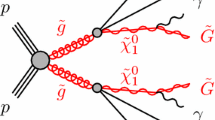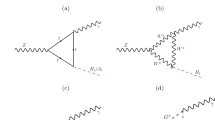Abstract
We study supersymmetric (SUSY) models in which the muon g −2 discrepancy and the dark matter relic abundance are simultaneously explained. The muon g − 2 discrepancy, or a 3σ deviation between the experimental and theoretical results of the muon anomalous magnetic moment, can be resolved by SUSY models, which implies at least three SUSY multiplets have masses of \( \mathcal{O}(100) \) GeV. In particular, models with the bino, higgsino and slepton having \( \mathcal{O}(100) \) GeV masses are not only capable to explain the muon g−2discrepancybutnaturallycontainstheneutralinodarkmatterwiththeobservedrelic abundance. We study constraints and future prospects of such models; in particular, we find that the LHC search for events with two hadronic taus and missing transverse mo-mentum can probe this scenario through chargino/neutralino production. It is shown that almost all the parameter space of the scenario can be probed at the high-luminosity LHC, and a large part can also be tested at the XENON1T experiment as well as at the ILC.
Article PDF
Similar content being viewed by others
Avoid common mistakes on your manuscript.
References
M.R. Buckley, D. Feld, S. Macaluso, A. Monteux and D. Shih, Cornering natural SUSY at LHC Run II and beyond, arXiv:1610.08059 [INSPIRE].
A. Choudhury, L. Darmé, L. Roszkowski, E.M. Sessolo and S. Trojanowski, Muon g − 2 and related phenomenology in constrained vector-like extensions of the MSSM, JHEP 05 (2017) 072 [arXiv:1701.08778] [INSPIRE].
A. Kobakhidze, M. Talia and L. Wu, Probing the MSSM explanation of the muon g − 2 anomaly in dark matter experiments and at a 100 TeV pp collider, Phys. Rev. D 95 (2017) 055023 [arXiv:1608.03641] [INSPIRE].
M. Chakraborti, U. Chattopadhyay, A. Choudhury, A. Datta and S. Poddar, Reduced LHC constraints for higgsino-like heavier electroweakinos, JHEP 11 (2015) 050 [arXiv:1507.01395] [INSPIRE].
M.A. Ajaib, B. Dutta, T. Ghosh, I. Gogoladze and Q. Shafi, Neutralinos and sleptons at the LHC in light of muon (g − 2) μ , Phys. Rev. D 92 (2015) 075033 [arXiv:1505.05896] [INSPIRE].
B.P. Padley, K. Sinha and K. Wang, Natural supersymmetry, muon g − 2 and the last crevices for the top squark, Phys. Rev. D 92 (2015) 055025 [arXiv:1505.05877] [INSPIRE].
F. Wang, W. Wang and J.M. Yang, Reconcile muon g − 2 anomaly with LHC data in SUGRA with generalized gravity mediation, JHEP 06 (2015) 079 [arXiv:1504.00505] [INSPIRE].
K. Kowalska, L. Roszkowski, E.M. Sessolo and A.J. Williams, GUT-inspired SUSY and the muon g − 2 anomaly: prospects for LHC 14 TeV, JHEP 06 (2015) 020 [arXiv:1503.08219] [INSPIRE].
T. Li and S. Raza, Electroweak supersymmetry from the generalized minimal supergravity model in the MSSM, Phys. Rev. D 91 (2015) 055016 [arXiv:1409.3930] [INSPIRE].
S.P. Das, M. Guchait and D.P. Roy, Testing SUSY models for the muon g − 2 anomaly via chargino-neutralino pair production at the LHC, Phys. Rev. D 90 (2014) 055011 [arXiv:1406.6925] [INSPIRE].
M. Chakraborti, U. Chattopadhyay, A. Choudhury, A. Datta and S. Poddar, The electroweak sector of the pMSSM in the light of LHC — 8 TeV and other data, JHEP 07 (2014) 019 [arXiv:1404.4841] [INSPIRE].
T. Cheng and T. Li, Electroweak Supersymmetry (EWSUSY) in the NMSSM, Phys. Rev. D 88 (2013) 015031 [arXiv:1305.3214] [INSPIRE].
Muon g-2 collaboration, G.W. Bennett et al., Final report of the muon E821 anomalous magnetic moment measurement at BNL, Phys. Rev. D 73 (2006) 072003 [hep-ex/0602035] [INSPIRE].
B.L. Roberts, Status of the Fermilab muon (g − 2) experiment, Chin. Phys. C 34 (2010) 741 [arXiv:1001.2898] [INSPIRE].
K. Hagiwara, R. Liao, A.D. Martin, D. Nomura and T. Teubner, (g − 2) μ and α(M 2Z ) re-evaluated using new precise data, J. Phys. G 38 (2011) 085003 [arXiv:1105.3149] [INSPIRE].
M. Davier, A. Hoecker, B. Malaescu and Z. Zhang, Reevaluation of the hadronic contributions to the muon g − 2 and to α M Z , Eur. Phys. J. C 71 (2011) 1515 [Erratum ibid. C 72 (2012) 1874] [arXiv:1010.4180] [INSPIRE].
J. Prades, E. de Rafael and A. Vainshtein, The hadronic light-by-light scattering contribution to the muon and electron anomalous magnetic moments, Adv. Ser. Direct. High Energy Phys. 20 (2009) 303 [arXiv:0901.0306] [INSPIRE].
F. Jegerlehner and A. Nyffeler, The muon g − 2, Phys. Rept. 477 (2009) 1 [arXiv:0902.3360] [INSPIRE].
J.L. Lopez, D.V. Nanopoulos and X. Wang, Large (g − 2) μ in SU(5) × U(1) supergravity models, Phys. Rev. D 49 (1994) 366 [hep-ph/9308336] [INSPIRE].
U. Chattopadhyay and P. Nath, Probing supergravity grand unification in the Brookhaven g−2 experiment, Phys. Rev. D 53 (1996) 1648 [hep-ph/9507386] [INSPIRE].
T. Moroi, The muon anomalous magnetic dipole moment in the minimal supersymmetric standard model, Phys. Rev. D 53 (1996) 6565 [Erratum ibid. D 56 (1997) 4424] [hep-ph/9512396] [INSPIRE].
J. Hisano, S. Matsumoto, M. Nagai, O. Saito and M. Senami, Non-perturbative effect on thermal relic abundance of dark matter, Phys. Lett. B 646 (2007) 34 [hep-ph/0610249] [INSPIRE].
M. Cirelli, A. Strumia and M. Tamburini, Cosmology and astrophysics of minimal dark matter, Nucl. Phys. B 787 (2007) 152 [arXiv:0706.4071] [INSPIRE].
M. Endo, K. Hamaguchi, T. Kitahara and T. Yoshinaga, Probing bino contribution to muon g−2, JHEP 11 (2013) 013 [arXiv:1309.3065] [INSPIRE].
S.P. Martin, A supersymmetry primer, Adv. Ser. Direct. High Energy Phys. 18 (1998) 1 [hep-ph/9709356] [INSPIRE].
H.G. Fargnoli, C. Gnendiger, S. Paßehr, D. Stöckinger and H. Stöckinger-Kim, Non-decoupling two-loop corrections to (g − 2) μ from fermion/sfermion loops in the MSSM, Phys. Lett. B 726 (2013) 717 [arXiv:1309.0980] [INSPIRE].
H. Fargnoli, C. Gnendiger, S. Paßehr, D. Stöckinger and H. Stöckinger-Kim, Two-loop corrections to the muon magnetic moment from fermion/sfermion loops in the MSSM: detailed results, JHEP 02 (2014) 070 [arXiv:1311.1775] [INSPIRE].
P. Athron et al., GM2Calc: Precise MSSM prediction for (g − 2) of the muon, Eur. Phys. J. C 76 (2016) 62 [arXiv:1510.08071] [INSPIRE].
N. Arkani-Hamed, A. Delgado and G.F. Giudice, The well-tempered neutralino, Nucl. Phys. B 741 (2006) 108 [hep-ph/0601041] [INSPIRE].
C. Cheung, L.J. Hall, D. Pinner and J.T. Ruderman, Prospects and blind spots for neutralino dark matter, JHEP 05 (2013) 100 [arXiv:1211.4873] [INSPIRE].
D. Barducci et al., Collider limits on new physics within MicrOMEGAs, arXiv:1606.03834 [INSPIRE].
M.A. Shifman, A.I. Vainshtein and V.I. Zakharov, Remarks on Higgs Boson Interactions with Nucleons, Phys. Lett. B 78 (1978) 443 [INSPIRE].
LUX collaboration, D.S. Akerib et al., Results from a search for dark matter in the complete LUX exposure, Phys. Rev. Lett. 118 (2017) 021303 [arXiv:1608.07648] [INSPIRE].
XENON1T collaboration, Physics reach of the XENON1T dark matter experiment, JCAP 04 (2016) 027 [arXiv:1512.07501] [INSPIRE].
A. Djouadi, M.M. Muhlleitner and M. Spira, Decays of supersymmetric particles: the program SUSY-HIT (SUspect-SdecaY-HDECAY-InTerface), Acta Phys. Polon. B 38 (2007) 635 [hep-ph/0609292] [INSPIRE].
ATLAS collaboration, Search for supersymmetry at the high luminosity LHC with the ATLAS experiment, ATL-PHYS-PUB-2014-010 (2014).
ATLAS collaboration, Prospect for a search for direct stau production in events with at least two hadronic taus and missing transverse momentum at the high luminosity LHC with the ATLAS Detector, ATL-PHYS-PUB-2016-021 (2016).
ATLAS collaboration, Search for electroweak production of supersymmetric particles in final states with tau leptons in \( \sqrt{s}=13 \) TeV pp collisions with the ATLAS detector, ATLAS-CONF-2016-093 (2016).
W. Beenakker, R. Hopker and M. Spira, PROSPINO: a program for the production of supersymmetric particles in next-to-leading order QCD, hep-ph/9611232 [INSPIRE].
H. Baer et al., Physics case for the ILC project: perspective from beyond the standard model, in the proceedings of Snowmass on the Mississippi (CSS2013), July 29-August 6, Minneapolis, U.S.A. (2013), arXiv:1307.5248 [INSPIRE].
Muon g-2 collaboration, J. Grange et al., Muon (g − 2) technical design report, arXiv:1501.06858 [INSPIRE].
Muon g-2 collaboration, A. Chapelain, The muon g − 2 experiment at Fermilab, EPJ Web Conf. 137 (2017) 08001 [arXiv:1701.02807] [INSPIRE].
J-PARC muon g-2/EDM collaboration, H. Iinuma, New approach to the muon g − 2 and EDM experiment at J-PARC, J. Phys. Conf. Ser. 295 (2011) 012032 [INSPIRE].
T. Blum et al., Connected and leading disconnected hadronic light-by-light contribution to the muon anomalous magnetic moment with a physical pion mass, Phys. Rev. Lett. 118 (2017) 022005 [arXiv:1610.04603] [INSPIRE].
J. Ellis, TikZ-Feynman: Feynman diagrams with TikZ, Comput. Phys. Commun. 210 (2017) 103 [arXiv:1601.05437] [INSPIRE].
Open Access
This article is distributed under the terms of the Creative Commons Attribution License (CC-BY 4.0), which permits any use, distribution and reproduction in any medium, provided the original author(s) and source are credited.
Author information
Authors and Affiliations
Corresponding author
Additional information
ArXiv EPrint: 1704.05287
Rights and permissions
Open Access This article is distributed under the terms of the Creative Commons Attribution 4.0 International License (https://creativecommons.org/licenses/by/4.0), which permits use, duplication, adaptation, distribution, and reproduction in any medium or format, as long as you give appropriate credit to the original author(s) and the source, provide a link to the Creative Commons license, and indicate if changes were made.
About this article
Cite this article
Endo, M., Hamaguchi, K., Iwamoto, S. et al. Probing minimal SUSY scenarios in the light of muon g−2 and dark matter. J. High Energ. Phys. 2017, 31 (2017). https://doi.org/10.1007/JHEP06(2017)031
Received:
Accepted:
Published:
DOI: https://doi.org/10.1007/JHEP06(2017)031




